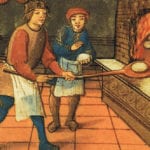 Mysteries
Mysteries  Mysteries
Mysteries  History
History 10 Surprising Stories About the Texas Rangers
 Humans
Humans 10 Philosophers Who Were Driven Mad by Their Own Theories
 Miscellaneous
Miscellaneous 10 Video-Game-Worthy Weapons and Armors from History
 Weird Stuff
Weird Stuff 10 Psychics Who Accurately Predicted Wartime Events
 The Arts
The Arts 10 Pieces of Art Inspired by a Broken Heart
 Health
Health 10 Science Fiction-Sounding New Medical Treatments
 History
History 10 Surprising Facts About the Father of Submarine Warfare
 Space
Space Ten Astonishing New Insights into Alien Worlds
 Weird Stuff
Weird Stuff 10 Bizarre Summer Solstice Rituals Still Practiced Today
 Mysteries
Mysteries Top 10 Haunting Facts About the Ghost Ship MV Alta
 History
History 10 Surprising Stories About the Texas Rangers
 Humans
Humans 10 Philosophers Who Were Driven Mad by Their Own Theories
Who's Behind Listverse?

Jamie Frater
Head Editor
Jamie founded Listverse due to an insatiable desire to share fascinating, obscure, and bizarre facts. He has been a guest speaker on numerous national radio and television stations and is a five time published author.
More About Us Miscellaneous
Miscellaneous 10 Video-Game-Worthy Weapons and Armors from History
 Weird Stuff
Weird Stuff 10 Psychics Who Accurately Predicted Wartime Events
 The Arts
The Arts 10 Pieces of Art Inspired by a Broken Heart
 Health
Health 10 Science Fiction-Sounding New Medical Treatments
 History
History 10 Surprising Facts About the Father of Submarine Warfare
 Space
Space Ten Astonishing New Insights into Alien Worlds
 Weird Stuff
Weird Stuff 10 Bizarre Summer Solstice Rituals Still Practiced Today
Top 10 Bizarre US Town Names
A rose by any other name would still be a rose. But were it called something silly, like Pukebud or Stenchflower, would it be the most overpriced florist flora come Valentine’s Day?
Names aren’t everything, but they’re certainly not nothing – unless, of course, you’re item #8 on this list. They can attract or repel, intrigue or dissuade and, as this collection shows, encourage widespread mockery.
10 Incredible People With Incredibly Unfortunate Names
10 Swastika, New York
Earlier this year, New York City resident Michael Alcamo was enjoying a vigorous cycling trip through upstate New York’s Adirondack Mountains, whose trails are dotted with quaint towns and historic Revolutionary War-era cemeteries. Winding through a stretch he’d never before explored, Alcamo bore witness to the most unorthodox street sign he’d ever seen.
He’d happened upon Swastika Road, the unassuming yet attention-grabbing main thoroughfare of the tiny, unincorporated hamlet of the same name. At a time when statues and place names with links to white supremacy are being debated across the U.S., Alcamo found the name unsettling; one could say he wishes he did “not see” it.
Apparently believing he’s the only person who ever thought a town named after the most reviled symbol in modern history should consider a rebrand, Alcamo contacted county officials to raise his concerns. Swastika was too small a town for its own council, so the matter was taken up by councilmembers of Black Brook, a nearby town of about 1,500 residents.
In September, the town’s four councilors unanimously voted against it. “Swastika was named by the founders of the area who settled there,” said Jon Douglass, Black Brook’s supervisor. The four-sided geometric character has been used for thousands of years in Indian religions and seen as a symbol of good luck, which promptly ran out around 1933.
Douglass said he understands why people might have a skeptical view of his beloved Swastika, considering – and I quote – “the Germans and everything,” who wore the symbol while committing genocide n’ stuff.[1]
9 Accident, Maryland

Drivers are advised to be extra cautious while passing through this sleepy Maryland town of 325. If a fender-bender occurs, they’ll need to wait for police to fill out an Accident accident report. And should the accident involve a local resident, it’s no accident that Accidentals (actual term) look out for one another when accidents happen in Accident.
The story of Accident beings with a… well, an accident. In the early 1770s, Marylander George Deakins was in line to receive 600 acres of the colony’s land – of his choosing – from King George II of England as a royal debt payment. To find the choicest property, he hired two separate surveyors to make their best recommendations.
Independently, each returned to Deakins with identical reports – a happy “accident.” The finest land in all the land, they claimed, rested between two distinct white oak trees, and was roughly the same size as that promised to Deakins. A nod to the coincidence, Deakins dubbed the area “The Accidental Tract.”
The American Revolution soon followed and, upon the war’s conclusion, Deakins portioned out the surrounding countryside into military lots and distributed acreage among soldiers and generals returning from battle. Accident wasn’t officially incorporated as a town until 1916, meaning no one bothered to think of a better name for over a century. The Drane House, which dates to 1798 and was among the first structures built in the settlement, still stands today.[2]
8 Knockemstiff, Ohio
The south-central Ohio town of about 56,000 is a joke writer’s dream. How many names open the door for violence, sex and the killer combo of sexual violence, all in just 12 letters?
Several competing origin stories exist concerning Knockemstiff’s name. One involves a massive brawl that allegedly took place during the community’s infancy, while another concerns some not-so-Christian advice from a preacher to a lady churchgoer seeking council about her husband’s infidelities. If he was knockin’ boots, reasoned the man of God, you should “knock him stiff.”
These tales, however, are mere hearsay, and naming a town after domestic violence or even a wide-scale royal rumble seems like a reach. Luckily, the likelier explanation for the town’s odd name is both more entertaining and historically referenced: moonshine.
During the American Prohibition period, which banned legal alcohol sales from 1920 until 1933, Knockemstiff was a haven for potent, amateur-concocted spirits. They were so popular that branding was common: the area’s moonshine frequently carried inventive names like Coffin Varnish, Tangle Leg, Stagger Soup and, semi-eponymously, NockUmStiff.
Of course, moonshine significantly predates the early 20th Century, as people have been making home-fermented alcohol for millennia. Nor are macabre monikers anything new. For example, during the American Civil War soldiers whipped up whimsical low-grade whiskies like Forty-Rod, Blue Ruin and Oh Be Joyful, often with ill-advised ingredients for added bite. Some even contained sulfuric acid or even strychnine, which could literally knock someone stiff.[3]
7 Buttzville, New Jersey
Oh… my… god, Becky. This is the second consecutive list that has presented the opportunity to reference that Baron of the Backside, Sir Mix-a-Lot. In 2020, you take your wins where you can get them. Welcome to Buttzville, a tiny, unincorporated township in northwestern New Jersey that aligns with the state’s stench-tastic derogatory nickname: the Armpit of America.
More PC than Assburg and more risqué than Tushytown, Buttzville was bestowed its bootylicious name in 1839 by Michael Robert Buttz, who purchased the land from a local gristmill operator. Buttz built a hotel (#BedButtz) at which several generations of little Buttzes continued to live and work for decades. Then as now, there aren’t many butts in Buttzville, as the current population is less than 150.
Notably Michael’s son, Charles Wilson Buttz, became a second lieutenant in the Union Army during the Civil War. He later served as a congressman from South Carolina before founding a town of his own in modern-day North Dakota. It’s name? You guessed it: Buttzville. Then a frontier village, the North Dakota location is now a ghost town, meaning Americans unfortunately can’t pick their Buttzvilles.[4]
6 Humptulips, Washington
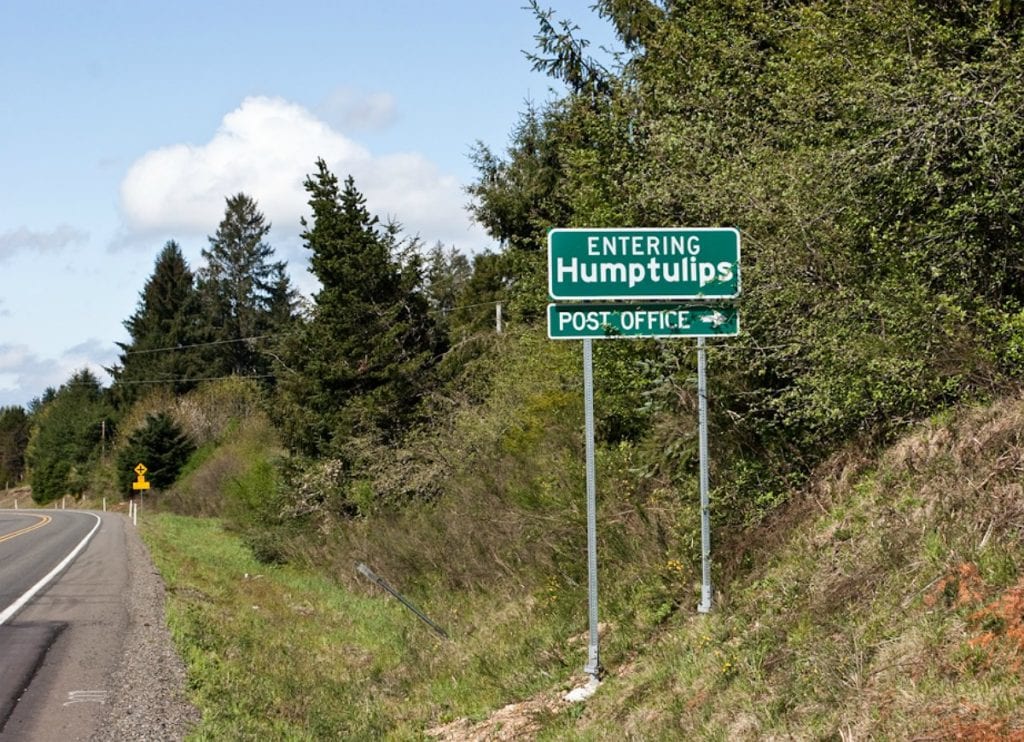
Humptulips is Exhibit A for a general rule of thumb: Great name for a bar means bad name for a town.
Located 25 miles north of Aberdeen – famous as Kurt Cobain’s hometown – this tiny burgh was, like much of western Washington, once a major logging hub; in fact, the term “skid row” comes from a well-worn pathway down which woodsmen would slide felled trees in the hilly city of Seattle.
Humptulip is one of the rare ridiculously-named places whose origin story is as funny as its current designation. The name derives from a local Native American word meaning – not kidding – “hard to pole”. The phrase refers to the indigenous peoples’ difficulty in navigating a nearby river of the same name; traditionally, Native Americans traversed waterways in canoes propelled with poles, and the Humptulip’s rough waters were especially arduous to power up or across.
Several popular works of fiction have paid homage to the flower fornicating town. Humptulips is mentioned in Tom Robbins’ “Another Roadside Attraction” as a base of operations for an order of assassin monks, and a book referenced in Terry Pratchett’s Discworld novel series cites a wizard named Humptulip as its author. It was no coincidence: Pratchett once called Humptulips his favorite place on Earth. Pervert.[5]
10 Fascinating Tales Of How Countries Got Their Names
5 Boogertown, North Carolina
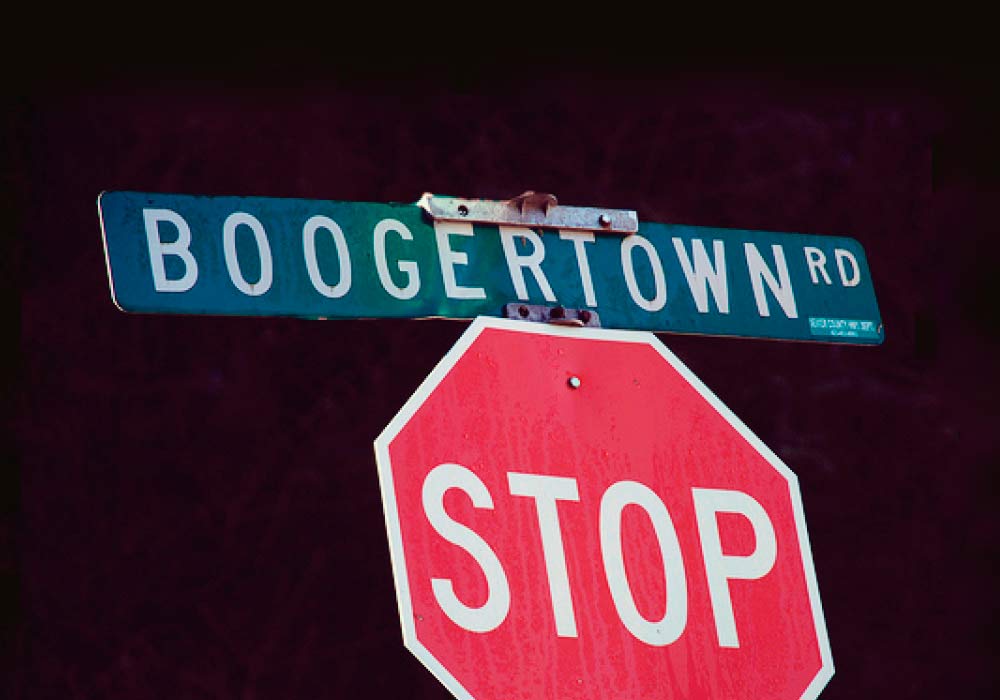
Precious metal prospectors take notice: there’s plenty of gold in them thar hills. Rolled gold, that is. No ax or shovel needed – just a good pick.
A suburb of Charlotte, North Carolina’s state capital, Boogertown is an unincorporated community of Gaston County, in the southwestern part of the state. Like Knockemstiff, its name also derives from illicit moonshine-making operations. Data on exactly when Boogertown earned its nostril-clearing name is snott… I mean, spotty, but many believe it also stems from the American Prohibition period of the 1920s and early 1930s.
Unlike Knockemstiff, however, Gaston County’s moonshiners were concerned not with bringing in customers but keeping other people’s noses out of their business. To deter would-be visitors, they invented a tell that a monster – a boogeyman – preyed on outsiders traveling through the area.
Today’s visitors to the Boogertown area have a plethora of winners from which to pick. Attractions include North Carolina Science Museum of Natural History, the sprawling Rankin Lake Park and, for vintage goods enthusiasts, an acclaimed 28,000-square-foot antique store. It’s name? Why, Gaston Pickers, of course.[6]
4 Blue Ball, Pennsylvania
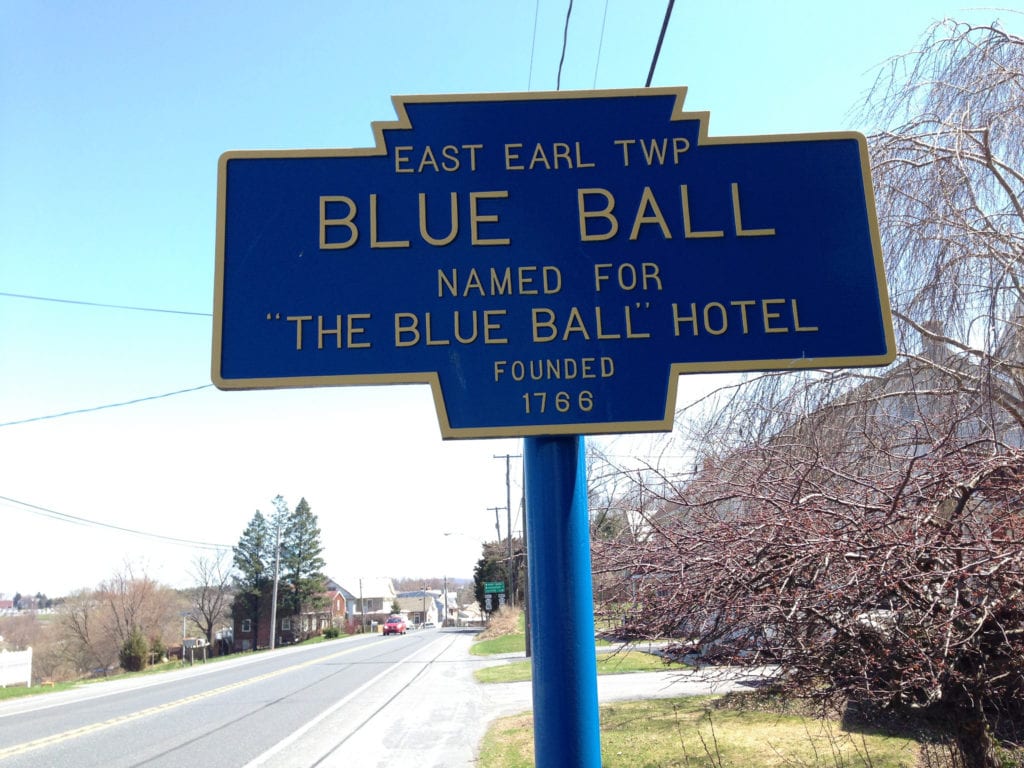
Many a man will agree that the only thing worse than getting blue balls would be only having one. But that’s the unfortunate reality for the frustrated menfolk of this testicularly troubling town in southeastern Pennsylvania.
Blue Ball’s name, of course, isn’t derived from sexually unsatisfied gentlemen residents. In the late 1700s, proprietor John Wallace constructed a humble building in what was then Earl Town, and converted the space into an inn. In an ingenious act of 18th Century marketing, Wallace hung a blue ball from a post outside the building to differentiate it from potential competitors, and called the distinguishing decoration “The Sign of the Blue Ball.”
The name stuck, and then some. Locals soon began calling not only the inn but also the town “Blue Ball” and, in 1833, Earl Town officially became Blue Ball. In the early 20th Century, the inn followed suit by changing its name to The Blue Ball Hotel – which, ironically, is also the nickname for this author’s bedroom.
Anecdotal symptoms of blue balls include mild testicular pain, an aching sensation at the base of the penis, heaviness of the scrotal sac and a faint blue tint to the testicles. People who deserve this deflating sensation include rapists, molesters and anyone with a man bun.[7]
3 Nothing, Arizona & No Name, Colorado

Why place two towns in one entry? No reason. None whatsoever.
Let’s start with Nothing, which today is literally nothing – and didn’t take very long to earn its name. The antithesis of prime real estate, the settlement lies 100 miles northwest of the bustling city of Phoenix, and about 20 miles south of Wikieup, known as “the rattlesnake capital or Arizona,” which is about as comforting as being called a “rabid raccoon mecca” or, like Churchill, Canada, a place where 1,000 flesh-eating polar bears roam the streets.
Nothing lasts forever… including Nothing. Today Nothing’s population is… nothing: zero. A signpost there reads: “The staunch citizens of Nothing are full of Hope, Faith, and Believe in the work ethic. Through the years, these dedicated people had faith in Nothing, hoped for Nothing, worked at Nothing, for Nothing.”
Meanwhile, No Name, Colorado actually was named. But like Not Sure from the cult classic (and current American reality) Idiocracy, it was basically a misunderstanding compounded with a clerical error. When the state sent out questionnaires to the hamlet’s inhabitants, which number barely more than 100, the majority wrote “No Name” in the section labeled “Name of Town.” The state took them at their word and officially recorded “No Name” into the state records, sealing the town’s notoriously anonymous fate.[8]
2 Truth or Consequences, New Mexico
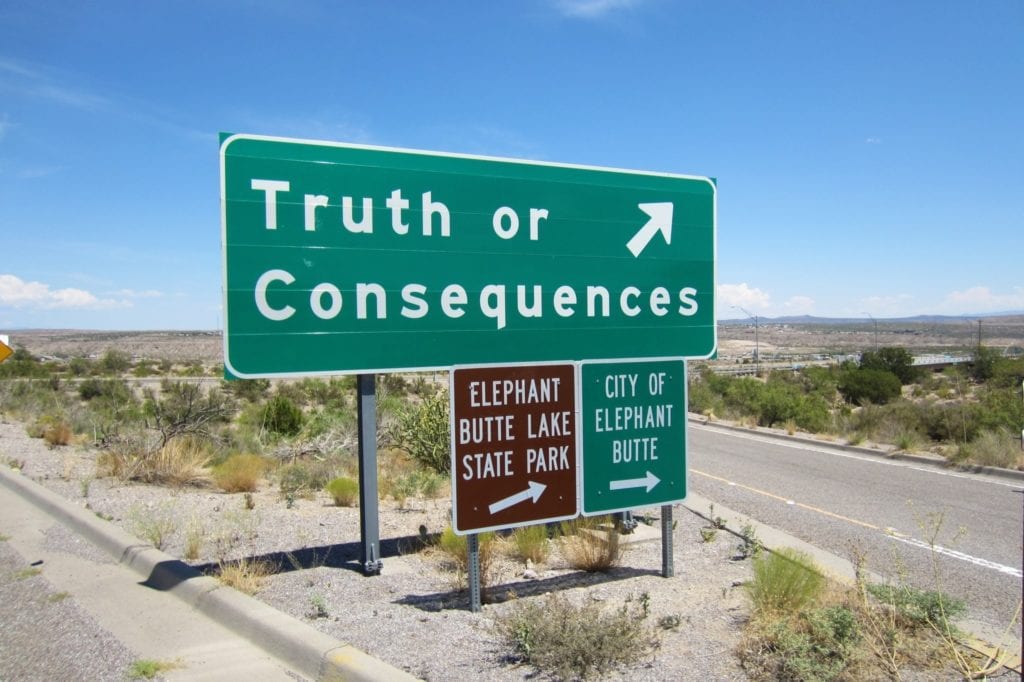
This small city in southwestern New Mexico exemplifies the fact that our choices have consequences. Because it’s arguably the stupidest name of any town on this list.
Why? Because Truth or Consequences, which locals call T or C for short, already had a terrific name that spoke to its distinctive appeal and, from a tourism perspective, its destination-worthy allure. The town is located near Elephant Butte Dam & Reservoir (another ridiculous name), part of a large-scale irrigation effort under an early 20th Century land reclamation act. Incorporated as Hot Springs in 1916, by 1930 the settlement had no less than 40 natural hot springs spas – one for every 75 residents.
When your town is purposefully and appropriately branded to being in tourism dollars, renaming it is idiotic. But that’s exactly what the brain trust in Hot Springs decided to do. Why? Because in 1950, a radio quiz show called Truth or Consequences said it would air a show from the first town that renamed itself after the program. Despite having a moniker perfectly befitting its best quality, Hot Springs leapt at the chance.
Truth of Consequences still comes up on lists of best spas in New Mexico, which only emphasizes the idiocy of foregoing long-term brand equity for some dope with a microphone on a medium about to be overshadowed by television. Doing so was akin to Dollywood decideing that “Wheel of Fortune” would do just fine so long as D-listers Pat Sajak and Vanna White did a show there.[9]
1 Satan’s Kingdom, Massachusetts
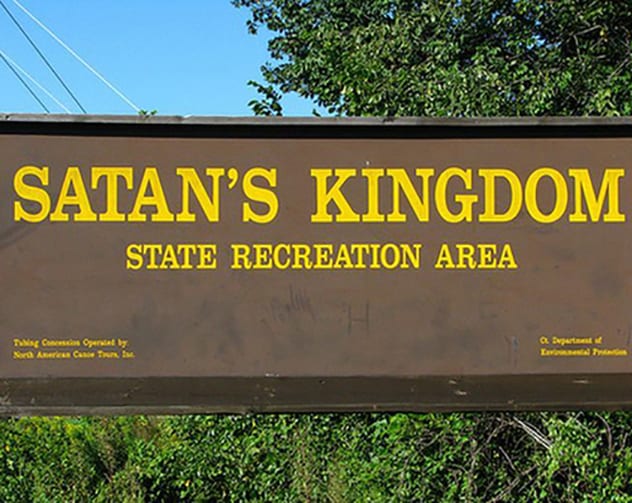
Per Charlie Daniels, when the devil once came down to Georgia lookin’ for a soul to steal, apparently he was visiting from New England.
Satan’s Kingdom has competing origin stories. The first dates all the way back to the 1670s, when European settlers first came to the area during a three-year conflict called King Philip’s War. Also known as the First Indian War, the violence pitted indigenous tribes against English settlers and certain native allies. Oddly, the war gets it name not from European royalty but rather a native chief called Metacom, a Wampanoag tribe leader who adopted the moniker Philip in honor of the friendly relations between his father, Massasoit, and the Mayflower Pilgrims of a generation earlier. In this version, Satan’s Kingdom denotes the especially brutal battles in which the Native Americans fought to keep the land they’d called home for centuries, if not millennia.
However, historians note that the area now known as Satan’s Kingdom lies about 10 miles from the fiercest fighting. A more plausible explanation comes from a coincidence combining the divine and the natural.
In the 1830s, New England was experiencing a feverish religious revival. In the adjacent town of Northfield, a preacher was giving a particularly spirited sermon leaning heavily on the “fire and brimstone” narrative permeating the days’ ecumenical lecturing. Upon exiting the service, churchgoers were aghast at a huge forest fire raging in a sparsely populated tract directly across the Connecticut River. Remarking on the conflagration, a worshipper is said to have remarked, perhaps tongue-in-cheek, that “the good parson’s prayer was being answered – Satan’s kingdom was on fire”.[10]
Top 10 Hilarious Scientific Names

